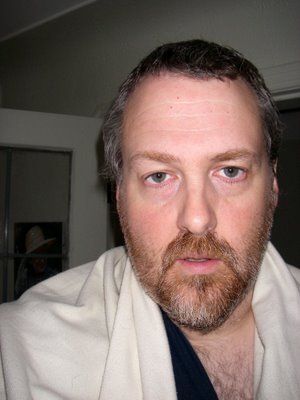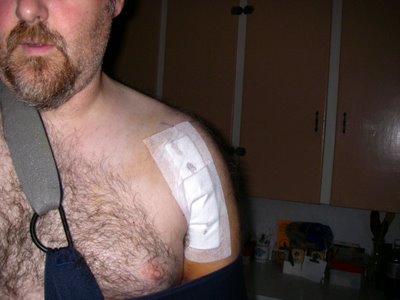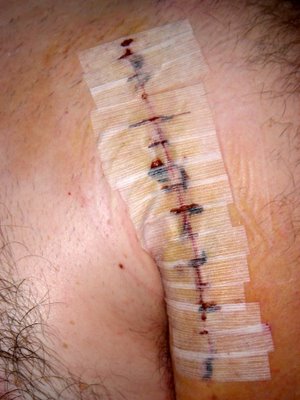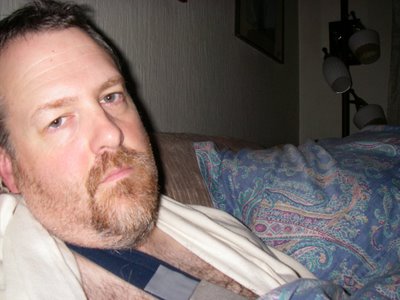I get to go home.
After more than 38 hours in hospital (4 of them in surgery having my left shoulder rebuilt after a bicycle accident), the nurse says I can go home. She pulls out a bag of my clothes and says, "Here. If you need help putting these on, I'll be back in a few minute."
I have a new 22cm-long surgical incision in my left arm and shoulder, freshly sutured and covered with a large bandage. My arm is tightly held in a sling. I'm loopy on morphine.
How the hell am I supposed to put clothes on?I can start by removing my hospital gown. It's practically falling off anyway. Because of my arm, it can't be fastened properly around me. Every time I've gone to the bathroom, my ass has been hanging out for all to see.
One little shrug and it's off. Modesty dies quickly in a hospital.
What's first? Well, underwear, I guess. It normally goes on first anyway (unless you're Madonna). Don't see why a busted shoulder should make any difference.
I'm not going to be able to reach down and hook the underwear over my feet while standing up. Bending over hurts. Doing much of anything hurts. And I have no balance. While I might able to get the right foot in the right hole with the right hand, getting the left foot in the left hole with the right hand will be impossible, and trying it with the left hand would probably leave me kissing the hospital floor.
The last thing I want to do is fall down again.
I sit on the bed. In a sitting position, I can hook my underwear over my feet and pull it up my legs with my right hand. Near the top, I can stand up and pull it over my butt.
Ta da. Blue Fruit of the Loom boxers are on.
Well, this procedure worked so well for underwear, it ought to work for pants, too.
And it does. Mind you, I have to figure out how to buckle them and my belt with one hand. It's not as easy as it sounds, but not so hard either.
Socks and shoes go on at the same time, too.
Now comes the shirt. My left arm is clearly not going into any sleeve, so I put my right arm in the right sleeve and then toss the left half of my shirt over my left shoulder. With my arm against my abdomen, I button it (one-handed) as far down as I can go.
When she returns, the nurse seems surprised that I was able to do it all myself. She pretends not to recognize me -- who is this well-dressed man and what have you done with my patient?
Thus beginith my recovery.My sister is playing taxi driver for me today (as she will for many weeks to come -- thanks, sis!).
The first order of business is to get me out. I have no idea where I am in the hospital. Left to my own devices, I might have been wandering the corridors for years trying to find the exit -- the
Flying Dutchman of Jubilee Hospital, ending up a crazy old man who mutters, "I beep at airports -- wanna see my scar?" to anyone who will listen.
But no, my dreams of becoming a human derelict end quickly as my sister finds the way out.
I walk gingerly. Falling down would be a disaster right now. But my first few haltingly hesitant steps are soon replaced with more confident paces. I'm not setting any records, but I start to feel safe on my feet.
Sis has brought the van -- a good thing. I don't think the MG would have been suitable. Climbing in isn't so bad, but the next stumbling block is the seatbelt -- I can't fasten it. I can pull it around myself, but sis has to snap it into its latch.
Can't do up a shirt properly, can't fasten a seatbelt. What else can't I do?
She drives me home, apologizing the whole way for every bump, stop, turn, braking maneuver and acceleration that occurs. Actually, it's not too bad. The right turns hurt the most as the inertia pulls at my left shoulder.
Finally, home. What does a man look like arriving home after major surgery for a crunched shoulder? Like this:

The first thing to do is to make me comfortable. The obvious place is the couch with lots of blankets.
My left arm is useless, so I have to sit on the right end of the couch so that I can use my right arm on the arm rest to help push myself up when I stand. I also need some pillows to support my battered left arm.
The downside is that now I can't curl up with my cat Linus, who has missed me and clearly realized something was up. In fact, we pile up extra pillows on the left side to keep Linus at bay; he's a large cat and likes to walk on me, and god forbid he should walk on my injured shoulder. Still, being home with my cat is a great start to my recovery, and he even seems to understand that although I am injured and can't really snuggle him, I did miss him and am glad for his company.

This is pretty much how I stayed for a couple of days. Sleep was impossible. Between the dull ache in my arm and my back stiffening up, there was no sleep to be had. In fact, I considered it an improvement when I was able to move to various chairs around the house during the night and not sleep in any of them. At least I was moving. But before I worried about my first night's sleep, there was another problem that I needed to face.
I needed to pee.
My bathroom is small. Tiny. The toilet is in a small alcove with little if any maneuvering room. And the transition from standing to sitting is painful and uncomfortable. And I am still wobbly. Pulling up my pants is awkward. So I have little choice. For the time being, I'm going to pee in the sink.
A couple of sleepless nights later, I was starting to smell. I needed a shower.
The only restriction I had about showering was to try and avoid having the shower spray directly on the incision. A little collateral water damage okay. I would also have to change my dressing afterwards. My dressing looked like this:

In order to have my shower, I would have to get undressed and get my arm out of the sling. Then I would gently get in the shower and somehow do all the necessary hair and body washing one-handed, then dry off, then get dressed again. My sister volunteered to stand by if needed. I told her that if she heard a splash and a thud followed by screaming, chances are that I would be in need of some assistance.
In actuality, the shower went well. Slow and steady wins the race.
The only problem was that I couldn't get my underwear on. Because of the aforementioned limited space in the bathroom, I had not yet managed to sit down on the toilet, and sitting down was the only way I could get pants and/or underwear on. Getting tired and a little frustrated that I couldn't devise a plan for my underwear, I had no choice but to call my sister through the closed bathroom door.
"Sis, I have a problem."
"What is it?"
"I can't get my underwear on."
"How did you get them on in the hospital?"
"I was on morphine. I don't remember."
"Oh."
"So I thought you could hold them in front of me. I'll step into them and you can start them up my legs. I should be able to grab them when they reach my calves and I can pull them up myself."
My sister reluctantly agreed. I opened the door a crack, and passed her my underwear.
"Are you ready?" I asked. She nodded.
I opened the door, naked as a skinny-dipper at Mackenzie Bight. She knelt in front of me, holding out the underwear and averting her eyes. I stepped in and reached down to grab the waistband.
"You'll have to lift them higher. I can't reach down that far."
She leaned in a little closer, and lifted them a bit higher. Now I could grab them.
"How's that?"
"That's great, sis, thanks. I got 'em. Don't hit your head on anything on your way up."
"Okay, glad I could--- oh, oh, you...."
She turned red and ran.
I went back into the bathroom and chuckled.
Then we changed the dressing. What did my incision look like? It looked like this:

I'm guessing 17 sutures. It's hard to tell, and they were dissolving sutures, so after a couple of weeks they were all gone anyway.
I had two big problems that first week. One, my arm was swelling up. I expected swelling around my shoulder and upper arm. That only made sense, that's where the injury and the surgery was, but the swelling was going down my arm towards my fingers, too. In fact, my fingers soon became giant white sausages. My whole arm was swollen and I was concerned, but the swelling soon passed and my arm returned to normal, Or what passes for normal these days.
The other problem was sleep. Or the lack thereof. After a couple of days, I moved off the couch and tried my bed. But nothing worked. I could not find a comfortable position or place to sleep. Worse, I was getting pretty wired from the Tylenol Extra Strength I was taking. I spent a couple of nights absolutely tripping out on the stuff. I took this picture at 3:00 one morning. Why? Because when you're basically immobile, dead dog tired, and hopped up on Tylenol, there really isn't much else to do at three AM except take your own picture.

My first physio appointment was a week after surgery. It snowed that day. Yes, my first trip out of the house with my busted shoulder and arm was on a day it snowed six inches.
At the rehab clinic, I meet Jim, my therapist. "Bike accident, eh?" he says. "Let's see what you did to yourself."
He consults my chart. "Uh huh, uh huh, hmmmm, uh huh, uh huh. Now that's interesting. Usually you don't see both of these injuries together. Usually, it's one or the other. But not both. Very unusual."
My elation upon hearing this knows no bounds.
There's not much treatment during this first session. Not much can really be done until the swelling in my arm starts subsiding. But he does ask if I have any problems.
"Can't sleep," I mumble between yawns.
"We can fix that."
He asks me to lie down on my back on the examining table, and he grabs some pillows. He sticks one under my head, a couple under my knees, and slides another one under my left arm, between it and my body.
Oh my. Suddenly, I'm totally relaxed.
That night I set up the pillows on my bed the way Jim did. I'm worried about Linus. Our ritual the past few years has been that he always jumps on the bed and curls in between my left arm and my body. If he tries that, it's going to hurt. I settle in with the light off and await Linus's arrival.
He hops up on the bed. Somehow he knows that the left side is off-limits. Without hesitating, he curls up in the crook of my right arm.
We both sleep for eight solid hours.
















